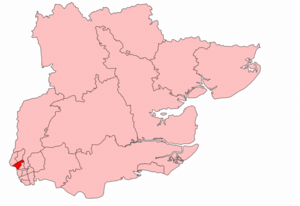Leyton West (UK Parliament constituency) facts for kids
Quick facts for kids {{{Name}}}[[{{{Type}}} constituency]] |
|
|---|---|
| [[Image:{{{Map1}}}Constituency.svg|120px|]] [[Image:England{{{Map2}}}.svg|120px|]] |
|
| {{{Name}}} shown within [[{{{Entity}}}]], and {{{Entity}}} shown within England | |
| Created: | {{{Year}}} |
| MP: | {{{MP}}} |
| Party: | {{{Party}}} |
| Type: | House of Commons |
| County: | [[{{{County}}}]] |
| EP constituency: | [[{{{EP}}} (European Parliament constituency)|{{{EP}}}]] |
Leyton West was a special area in the United Kingdom where people voted for a Member of Parliament (MP). This area was part of the Municipal Borough of Leyton, which used to be in Essex but is now part of Greater London.
Each constituency, like Leyton West, chooses one MP to represent its people in the House of Commons. This is the main place where laws are made in the UK. The MP was chosen using a system called "first past the post," which means the candidate with the most votes wins.
Contents
History of Leyton West Voting Area
The Leyton West voting area was created for the general election in 1918. It was used for elections until the 1950 general election, when it was changed and no longer existed as a separate area.
Where Was Leyton West Located?
The Leyton West constituency covered specific parts of the Urban District of Leyton. These parts were known as the Central, Forest, Lea Bridge, and Leyton wards. A ward is a smaller local area within a town or city.
People Who Represented Leyton West
The people listed below were the Members of Parliament (MPs) for Leyton West. They were elected by the local voters to speak for them in the UK Parliament. Each MP belonged to a political party, which is a group of people who share similar ideas about how the country should be run.
| Election | Member | Party | |
|---|---|---|---|
| 1918 | Harry Wrightson | Unionist | |
| 1919 | Alfred Newbould | Liberal | |
| 1922 | James Cassels | Unionist | |
| 1929 | Reginald Sorensen | Labour | |
| 1931 | Sir Wilfrid Sugden | Conservative | |
| 1935 | Reginald Sorensen | Labour | |
| 1950 | constituency abolished: see Leyton | ||
How Elections Worked in Leyton West
Elections are how people choose their representatives. In Leyton West, voters would go to polling stations to cast their ballots. The candidate who received the most votes in the constituency would become the MP.
Key Elections in the 1910s
- 1918 General Election: This was the first election for Leyton West. Harry Wrightson from the Unionist Party won with 67.4% of the votes.
- 1919 By-election: A by-election happens when an MP leaves their job before the next general election. In 1919, Alfred Newbould from the Liberal Party won this by-election with 57.3% of the votes.
Key Elections in the 1920s
- 1922 General Election: James Cassels from the Unionist Party won this election.
- 1923 General Election: James Cassels won again, but by a very small number of votes.
- 1924 General Election: James Cassels was re-elected for the Unionist Party with a larger lead.
- 1929 General Election: Reginald Sorensen from the Labour Party won this election. This was a change from the Unionist Party.
Key Elections in the 1930s
- 1931 General Election: Sir Wilfrid Sugden from the Conservative Party won by a large margin.
- 1935 General Election: Reginald Sorensen from the Labour Party won back the seat. He won by a very small number of votes, only 128 more than his opponent.
Key Elections in the 1940s
- 1945 General Election: This election happened after World War II. Reginald Sorensen from the Labour Party won again with a strong majority. He received 58.5% of the votes.
After the 1945 election, the Leyton West constituency was changed. For the 1950 general election, the area became part of a new constituency called Leyton.


